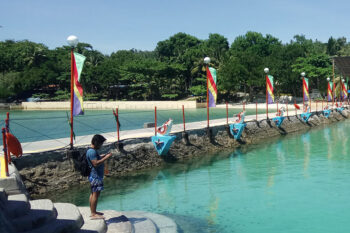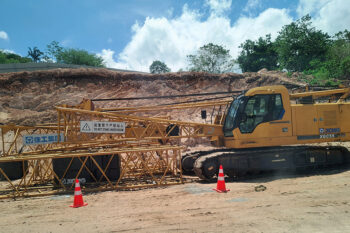DAVAO CITY (MindaNews/15 January) – We were prepared to ride the habal-habal once again on Saturday. This time, Toto Lozano will go with me and Ruby will shoot for mining-related issues in Pantukan.
Bibo was already waiting for us near the town hall when we arrived. It was 9:30 a.m.
For an out-of-town coverage like this one, it is important to maintain one driver, especially so because this is not an easy drive to the site. It is important to entrust your safety to someone experienced. Habal-habal drivers also serve as your local guide as almost everyone in the village knows them, and vice versa.
Trust your driver and trust his motorcycle. Ordinary motorcycles could not easily make it to the gold-rush sites. Habal-babals are heavily modified motorcycles.
On that day, we headed to Sitio Panganason to descend from Sitio Haguimit again via the Nangkaan trail, so named because of the many jackfruit trees in the area.
After more than an hour’s ride over rough roads, we reached sitio Haguimit. As we descended, the trail looked better compared to our first day. It was not as slippery as on Thursday (January 5). We learned that the miners restored the trail so that it would easier for rescue volunteers to move back and forth.
It was almost 12 noon when we arrived. Most of the volunteers were having their lunch at the bunkhouse of Hexat Mining. No one was left digging. While waiting, we took few a shots. Then we descended again near the foot of the landslide site.
About five minutes later, the small-scale miners emerged from the shanties and resumed digging.
Looking for Cho-cho
I saw Bernabe again. He was still quiet but kept on digging using a shovel. He hasn’t found Cho-cho yet. I wanted to ask him Cho-cho’s real name, but I did not anymore. I wanted to give him some space.
This time, he was joined by his sister and two brothers-in-law. A TV reporter had just finished interviewing his sister. I learned from his sister that Bernabe only had one meal since the landslide happened. So that was one meal in three days.
On barefoot, Bernabe looked pale but he was still strong. He dug into the earth using the shovel with so much force as if he could break his tool. If I could just read his mind, I think he was hoping that every rock he turned, he could find his daughter.
I wanted to talk to him again but his actions showed his frustration. So I opted not to interview him anymore. I took a few shots and observed him and his fellow miners digging through the mud and rubble.
He unearthed a piece of cloth, and stared at it for few seconds. Maybe he was wondering if that was from his destroyed house. Then he threw it away and started plowing again. He struck the earth and the mud so hard, his shovel hitting some rocks.
His fellow miners were pouring water beside a big rock about a meter wide to soften the earth around it and thus easier to push. Bernabe’s colleagues were shouting at him to move out of the way because the rock was about to roll towards him.
“Abe, padaplin! Mabali ng imong tuhod kung maipit ka anang bato!” one of the miners yelled.
But Bernabe ignored him, continuing to dig through the mud beside the rock. As the boulder started to roll, he jumped to the top of the rock, then pushed it downwards with his feet and immediately had a peek behind the rock. He must be hoping to find the body of his daughter.
But there was none. Frustration was written all over his face.
We could smell the stench of death around. Flies were everywhere.
Then one miner started digging where the flies were, a few meters away from Bernabe. The miner called up his colleagues to dig on that spot because he could smell something. After a foot deep of digging, one of them hit something soft. It smelled so bad. Some rushed to the spot to see what it was.
Bernabe stood and looked towards them. As it turned out, it was just a slice of pork. Then I noticed Bernabe walking away. Just about two meters away, he sat on a pile of lumber gathered from destroyed houses.
I moved downwards, deeper into the foot of the landslide where most of the miners were digging because it was there where they retrieved most of the bodies.
When I looked up, I saw Bernabe still sitting on the pile of lumber, his head down resting on his arms crossed over his knees. He was shaking his head slowly, apparently crying. I looked for Toto because I knew he had his telephoto lens with him. I only had a standard zoom lens mounted on my camera, I could thus not get a much better shot since Bernabe was out of my range.
Then I saw Toto taking pictures of him. I signaled Toto to keep on shooting. It was a dramatic picture that would show his frustration while his daughter has yet to be found.
Soldiers, police no more
We noticed that it’s already 2 p.m. and the other rescue volunteers – like those from Apex Mines, military and police – were no longer around. I thought they would resume digging after having their lunch.
No more journalists too, except for one foreign TV crew.
Anyway, the miners continued digging.
On alert
Suddenly, everyone scampered for safety because the police in the upper part of the hill ordered them to stop digging because the debris was moving.
I was interviewing the leader of the miners when everyone ran. He radioed his men who were monitoring the movement of the fissure near the origin of the landslide.
He said everything was okay and that there was no need to panic. He ordered his colleagues to continue digging. I was confident, I trust him more than the policemen because he has been living and working there for 30 years.
The miners said it was because of a leaking water hose that caused the mud to fall off a cliff. I
already noticed when we arrived.
I looked for Toto, I saw him in the higher portion of the hill. I signaled him a thumbs up, meaning “I’m okay here.”
The miners continued digging. A police officer arrived with his small megaphone, saying something that we could not hear amid the noise from the shovels and the crumbling .
The miners ignored the police and continued digging. The police officer left. I saw Toto looking at the digging. At 2:45 p.m., I signaled him that we would leave by 3 p.m.
The smell was getting worse. Then they found a body part. They continued digging until they found a leg. The miners poured more water until a hand surfaced.
Looking for Ange
One miner said: “I hope that’s Ange now.” Someone asked what Ange was wearing the last time they saw him on Wednesday evening. One of the miners said: “ A red and black sweat shirt.”
The volunteers found a piece of cloth of red and black. Somebody whispered again, saying: “Unta si Ange na gyud na.”
Ange’s name was like “talk of the town” in the gold-rush site.
After 15 minutes, they have fully retrieved the body and transferred it to the body bag. But they were not sure if it was Ange or not. They could hardly recognize the deformed face.
Toto was already around taking pictures of the retrieval. I was moving away once in a while because of the stench.
It was not the first time that I saw and took pictures of a dead body. But I was looking for an angle that would not show the dead man’s face nor all of his body. If you want to shoot a dead body, shoot it with dignity.
Almost everyone had his nose covered because of the stench, but a few could withstand it.
After the body was taken to the “temporary morgue,” we decided to head back to the town proper.
While ascending, I looked back to the shanties standing on the edge of the mountain, thinking what awaits them since the village has been identified as a high-risk area.
Back in sitio Haguimit, we passed by a store for a quick snack. Toto, Bibo and myself were already starving. We ordered three cups of instant noodles.
Then we heard a motorcycle roaring through the narrow road. One of the villagers shouted: “Abe, kita na bata mo?” Then a male voice answered: “Wala pa!”
I did not immediately recognize that it was Bernabe, who was riding on a motorcycle heading to sitio Panganason. I was facing the store when they passed by. But I saw his back, he was still wearing the dark blue shirt and short pants, the same set of clothes since Day One of the rescue operations.
It was the loudest voice I heard from him since I saw him digging through the rubble. Those who asked him were not strangers, they were his fellow miners.
At the store, I asked Rosebeth Hilamon, the owner, if they were not afraid of the landslide. She replied: “Wala man, naanad naman mi ana dire.”
Hilamon, who has been living in sitio Haguimit for 14 years, said they used to own a ball mill plant in Sitio Diat 2, but it was hit by the landslide.
Then I asked her who Ange was. Ange was a gold buyer in Sitio Diat 2 who used to own a store and a billiard table, where miners while away the time, drinking beer and playing billiards.
I checked the Philippine National Red Cross’ the list of missing persons. There I learned that Ange’s real name is Angelito Ubas; Cho-cho is Chona.
After talking to several miners, they said landslides have become a part of their lives. Poverty has pushed them to work in the mines, digging not just for the gold, but their own graves as well.
As of this writing, 40 bodies have been retrieved from the site while 41 are still missing.
The retrieval operations have ceased. Ange and Chona would remain on the missing list.
Like in the previous landslides, many have remained missing. It was impossible for the volunteers to retrieve the bodies due to the deep mud and the rubble.
The landslide sites have become a poor man’s grave. (Keith Bacongco / MindaNews)
[NOTE: Sorry for the mix-up, but the previous dispatches were not labeled properly.







